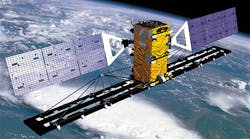Canada’s RADARSAT Constellation Mission (RCM), which aims to ensure C-band data continuity via enhanced synthetic aperture radar (SAR), received a helping hand from Astro Aerospace. The company recently delivered 13 lightweight antennas—all capable of self-deploying in 200 ms—in support of the mission. The antennas will be built into RCM Earth Observation satellites that can be used for everything from maritime surveillance to disaster management to ecosystem monitoring.
Integration of the highly configurable, stored-energy monopole antennas into the satellites’ automatic identification system (AIS) payload will enable identification of any ship, as well as supply position, course, and speed data. The stowed package is relatively small and compact for a deployable antenna of a given size—13 antennas can be stored in a low-mass, 4- by 4- by 2.5-in. canister. The antennas are also available in monopole diameters from 0.5 to 1.375 in., as well as any length up to 25 ft. They can be used as very-high-frequency (VHF), ultra-high-frequency (UHF), or broadband receive antennas.
Complementing the SAR payload, the AIS payload will be able to receive messages in a wider swath. The three-satellite RADARSAT constellation, expected to launch in 2018, will provide complete coverage across all of Canada’s land and oceans.
The monopole antennas were previously used for the latest GPS III satellites (see “JIB Antennas Will Form Array for GPS III Satellites” at Microwaves & RF).

